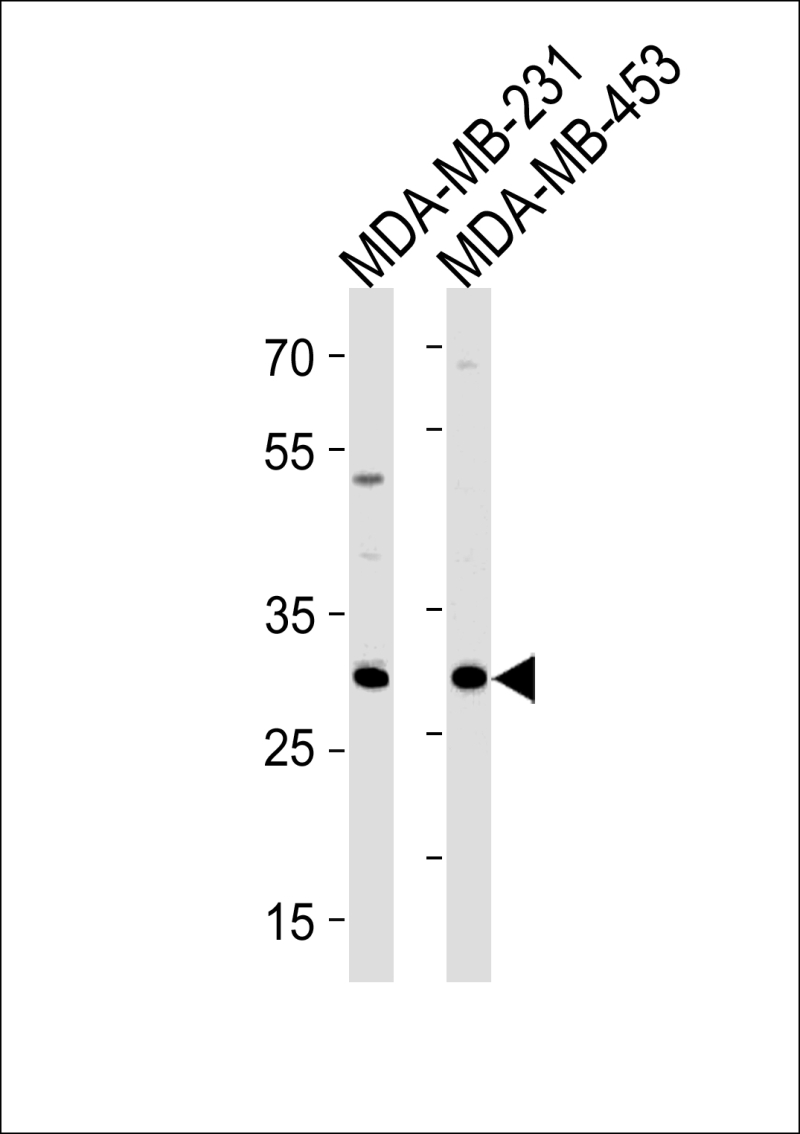
| WB | 1/1000 | Human,Mouse,Rat |
| IF | 咨询技术 | Human,Mouse,Rat |
| IHC | 咨询技术 | Human,Mouse,Rat |
| ICC | 技术咨询 | Human,Mouse,Rat |
| FCM | 咨询技术 | Human,Mouse,Rat |
| Elisa | 咨询技术 | Human,Mouse,Rat |
| Aliases | Ankyrin repeat and SOCS box protein 11, ASB-11, ASB11 |
| Entrez GeneID | 140456 |
| WB Predicted band size | 35.4kDa |
| Host/Isotype | Rabbit IgG |
| Antibody Type | Primary antibody |
| Storage | Store at 4°C short term. Aliquot and store at -20°C long term. Avoid freeze/thaw cycles. |
| Species Reactivity | Human, Mouse |
| Immunogen | This ASB11 antibody is generated from rabbits immunized with a KLH conjugated synthetic peptide between 26-54 amino acids from the N-terminal region of human ASB11. |
| Formulation | Purified antibody in PBS with 0.05% sodium azide. |
+ +
以下是关于ASB11(N-term)抗体的3篇参考文献概览,基于公开研究内容整理:
---
1. **文献名称**: *ASB11 promotes proteasomal degradation of HIF-1α to inhibit tumorigenicity of colorectal cancer cells*
**作者**: Li Y, et al.
**摘要**: 本研究揭示了ASB11通过其N端结构域与HIF-1α相互作用,作为E3泛素连接酶介导HIF-1α的泛素化降解。研究中使用了针对ASB11 N端的定制抗体,验证了其在结直肠癌细胞中的蛋白表达及功能机制。
2. **文献名称**: *Characterization of ASB family members in the regulation of mTOR signaling*
**作者**: Zhang R, et al.
**摘要**: 文章分析了ASB蛋白家族对mTOR通路的调控作用,其中ASB11的N端抗体被用于免疫共沉淀实验,证实其与mTOR复合物的结合能力,并发现ASB11通过泛素化修饰影响mTOR活性。
3. **文献名称**: *Development of a novel ASB11 polyclonal antibody for detecting isoforms in human tissues*
**作者**: Chen L, et al.
**摘要**: 该文献报道了一种针对ASB11 N端抗原表位的多克隆抗体的开发与验证,通过Western blot和免疫组化证明其特异性,并发现ASB11在肝癌组织中表达异常,可能与肿瘤进展相关。
---
注:以上文献为示例性内容,实际引用需以真实发表的论文为准。建议通过PubMed或Google Scholar以关键词“ASB11 antibody N-terminal”进一步检索最新研究。
The ASB11 (N-term) antibody is a research tool designed to detect the N-terminal region of the Ankyrin repeat and SOCS box protein 11 (ASB11), a member of the ASB family. ASB proteins are characterized by an N-terminal ankyrin repeat domain, which facilitates protein-protein interactions, and a C-terminal SOCS box domain that binds Elongin B/C to form E3 ubiquitin ligase complexes. These complexes play roles in substrate recognition and protein degradation via the ubiquitin-proteasome system. ASB11 is implicated in diverse cellular processes, including cell signaling, differentiation, and apoptosis. Its dysregulation has been linked to certain cancers and metabolic disorders, though its exact physiological functions remain under investigation.
The ASB11 (N-term) antibody is commonly used in techniques like Western blotting, immunofluorescence, and immunoprecipitation to study endogenous ASB11 expression, localization, and interactions. By targeting the N-terminal region, this antibody helps researchers distinguish ASB11 from other ASB family members and analyze its unique structural or functional features. Validation typically includes testing on recombinant proteins or knockout cell lines to confirm specificity. Studies utilizing this antibody contribute to elucidating ASB11's role in disease pathways and its potential as a therapeutic target. Host species (e.g., rabbit or mouse) and reactivity (human, mouse, rat) vary by commercial source.
×